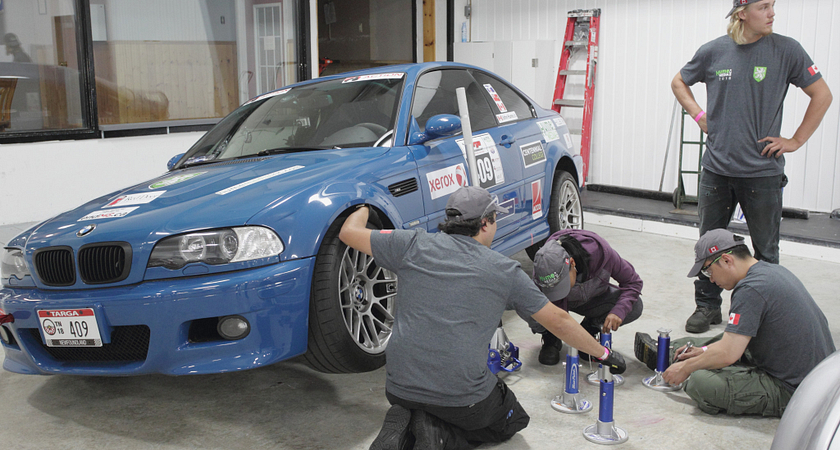Punctuated by driving rain, wind, cold and a little sun, the Targa Newfoundland auto rally unwinds over 1,500 km of paved and gravel roads on The Rock, Canada’s easternmost province in the North Atlantic. It’s so grueling that up to one-third of the vehicles that start the race don’t finish due to mechanical failure. That’s where Centennial’s automotive technician students get involved.
Professor Garrett Nalepka of Centennial’s School of Transportation is an automotive tech professor in the Chrysler Co-op program, and has experience supporting a Dodge Viper racecar in the World Challenge B Series. He’s travelled several times to wrench at Targa Newfoundland, supporting the Hume Media team by keeping their cars in peak condition over the weeklong event.
For Nalepka, the Targa represents a learning opportunity. This September, he was accompanied by automotive students Sooan Jang, Randy Yerxa, Alistair Hutton and Leyana Proferio, along with the school’s Dean, Alan McClelland, to work on the cars between the timed stages and at night while the drivers slept. It’s a once-in-a-lifetime experience no student will soon forget.
“The event is just as much a test of endurance for the service crew as it is for the drivers,” says McClelland, who worked in the auto industry before he returned to Centennial (he’s a proud graduate) as dean. “We were busy all day and then into the evenings doing the service work. Most of what we performed was fairly basic, but we had to do it accurately in a short period of time.”
Newfoundland is notorious for its frost-heaved roads beyond the main Trans-Canada Highway, which take their toll on car’s brakes, suspension and steering components. Everything gets checked on the cars daily – the team was looking after five of them, including a Nissan Juke driven by journalist Jim Kenzie – and there’s no shortage of repair work to do, sometimes at the side of the road and sometimes in local hockey arenas made available to the race teams.

“The cars bottom out at high speeds on some of the stages, so we need to check for resulting damage. We have limited time during the days between stages, so only urgent items are dealt with, if the cars can still run,” says McClelland. The BMW M3 driven by John Hume Jr. blew an accessory drive belt halfway through one of the stages and kept racing with no water pump and no power steering until the end of the timed stage.
“We had a belt and got it changed in 15 minutes. The engine had cooled enough to top up the coolant and they were on their way to the next stage, where they broke a stabilizer link. We checked it and confirmed that the car was safe to drive, so they ignored the loud clanking noise and finished in first place.”
The teams travel with lots of spare parts, tires and wheels loaded on trailers and taken from town to town to support the race effort. But sometimes an odd part breaks and there’s little that can be done. One of the Hume Minis blew a piston at the end of a stage, but it was more than the team was equipped to deal with, so the car was retired.
Still, having four cars out of five finish the race is better than the average. And it wasn’t just a matter of finishing. The four Hume Media vehicles finished first, second and third in the Modern class, and second in the GT class.
“I guess you could say we owned the podium,” quips John Hume Sr., who leads the team that calls Scarborough home – which happens to be Centennial’s headquarters, too. He gets philosophical when he’s asked about the appeal of piloting a racecar: “Nothing ventured, nothing gained. Life is too short to sit on the sidelines.”
Alan McClelland is equally impressed with Targa Newfoundland’s ability to change people and leave them with an indelible experience: “It was great to see students’ confidence grow over the week as they got used to the less-than-perfect working conditions.” Needless to say, the team will be back next year.
